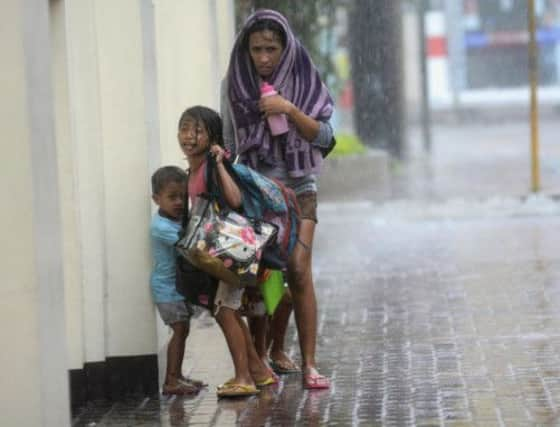Philippines typhoon could be strongest ever seen


The storm is thought to be at least twice the size of the one that hit parts of Britain last month, which also left four people dead and caused widespread destruction.
Typhoon Haiyan has left a trail of devastation in its wake across the islands, with hundreds of thousands of people forced to flee their homes.
Advertisement
Hide AdAdvertisement
Hide AdExperts believe the typhoon will rumble inland and west towards Laos over the weekend, before fizzling out with heavy rainstorms. Officials said more than 12 million people were at risk, but hoped the storm’s rapid passing could limit its impact.
Lieutenant General Roy Deveraturda, a regional military commander, said: “It has helped that the typhoon blew very fast in terms of preventing lots of casualties.”
Meteorologists had warned the storm could be as devastating as Typhoon Bopha in 2012, which ravaged parts of the southern Philippines and left at least 1,000 people dead.
Haiyan – equivalent to a category five hurricane – is now heading towards Vietnam and southern China.
Paul Knightley, forecast manager at MeteoGroup, the weather division of the Press Association, described Haiyan as “one of the strongest typhoons ever seen before on the planet in the modern age”.
He added: “As far as tropical storms go, this is about the top of the ladder. Sustained winds are hitting landfall at around 190mph, then gusting over 230mph. It is an incredibly powerful storm, which has now moved through the Philippines. No doubt we will see all sorts of damage has been caused.
“The damage that this storm could do is hugely greater than the storm we had last month.”
The Philippines, which is hit by about 20 typhoons and storms annually, has in recent years become more serious about preparations to reduce deaths. Public service announcements are more frequent, as are warnings issued by the president and high officials, which are regularly carried on radio, TV and social networking sites.
Advertisement
Hide AdAdvertisement
Hide AdRoger Mercado, governor of Southern Leyte province, said the typhoon triggered landslides that blocked roads, uprooted trees and ripped roofs off houses around his residence. He added that the dense clouds and heavy rains made the day seem almost as dark as night. “When you’re faced with such a scenario, you can only pray, and pray, and pray,” he said.
Provincial governors and mayors have taken a hands-on approach, supervising evacuations, inspecting shelters and stockpiling supplies.
Among the evacuees were thousands of residents of Bohol, who have been camped in tents and other makeshift shelters since a magnitude-7.2 earthquake hit the island province last month. Relief workers said they were struggling to find ways to deliver food and other supplies, with roads blocked by landslides and fallen trees.
The storm “unleashed fierce winds and harsh rains that uprooted big trees and toppled electric poles and power lines,” said Aaron Aspi, a spokesman for World Vision in Bohol.
Aid agencies warned that the full extent of Typhoon Haiyan had not been realised last night.
Minnie Portales, for World Vision in the Philippines, said: “This storm was much stronger than Typhoon Bopha last year, and that storm killed more than 1,000 people and destroyed at least 216,000 homes. We fear the worst. This could be very bad.”
Anna Lindenfors, Save the Children country director for the Philippines, added: “We expect the level of destruction caused by Typhoon Haiyan to be extensive and devastating, and sadly we fear that many lives will be lost. As the storm batters across the country, homes, schools and offices are being destroyed by the record-breaking winds. The storm surge is causing widespread flooding.”
But others said they had avoided the casualties which could have occurred, due to swift action. “It has helped that the typhoon blew very fast in terms of preventing lots of casualties,” said Lt Gen Deveraturda.
Advertisement
Hide AdAdvertisement
Hide AdThere were reports of substantial damage even in areas that missed the worst of Haiyan, the 25th tropical storm to enter Philippine territory this year.
The Philippines has experienced more than its fair share of super typhoons in recent years, said experts. There were at least three in nine of the ten years between 2002 and 2012.
The islands are scattered along the world’s most active typhoon belt where plentiful supplies of warm water and moist air provide the energy to kick-start super storms.